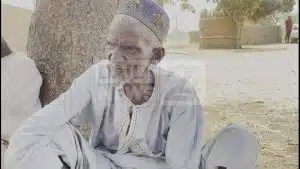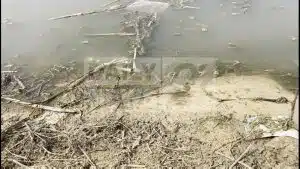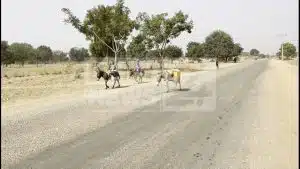It was a sunny yet hazy day in the Yandachi community of Warawa Local Government Area (LGA) of Kano State, North-West Nigeria. As the icy wind blew into the air, only a handful of residents were outdoors going about their activities.
It is currently harmattan season, and as the seasons wears on, many prefer to stay indoors, receiving the warmth that comes from their beds and blankets in their thatched-roofed muddy houses.
- Kano govt to inaugurate industrial wastewater treatment project
- NAFDAC uncovers ‘ghost’ sachet water factories in Yola – State coordinator
The scarcity of clean drinking water in this community has led residents into drinking the same water they give their animals.
Warawa is just 11 kilometres away from the Kano metropolis, an average 24 minutes’ drive from the city.
Safe drinking water is essential for public health irrespective of whether it’s used for drinking, cooking, domestic use or sanitation.
The Sustainable Development Goals 6 (SDG 6) focuses on clean drinking water and sanitation for all. Its emphasis is to ensure the availability, sustainability and management of water and sanitation for all, to be accomplished before 2030.
In Yandachi village, their water source is about 1 kilometre away from the community, in a ditch that harbours brownish coloured water.
Residents trek 5km to access portable water
To access nearly clean water, they have to walk as far as 5 kilometres before they can have any hope of accessing almost pure water.
Sometimes, after walking such a distance and queuing for hours to fetch water from the manual hand pump, their hopes are dashed, and they have to make do with any quality of water they can get from any source close by.
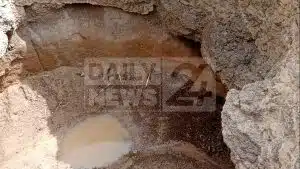
Typically, children are saddled with the responsibility of fetching water for their households and are required to head to the nearest available water source early in the morning.
After spending long hours searching for water, they get back home at late hours, tired and hungry, and due to this condition, many children don’t go to school.
Water is more essential than schooling
Yusuf Sa’adu, a Yandachi resident who is in his early forties while sitting beside the ditch, quenches his thirst with the brownish looking water and explains to Daily News24 that the water gotten from the ditch is used by the community members for cooking, ablution, feeding animals, washing clothes and other domestic purposes.
“We have no better source of water than this in our community. If we want nearly better water than this one, we have to walk about 5 kilometres to get it.
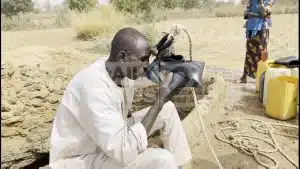
“Since we can’t get any cleaner water, we are stuck with this brownish looking water which is just about 1 kilometre away from the community.
“This ditch is our only hope of getting water in this community. As you can see here, the water is almost dried up because of the weather, and we have to wait for some time before it reaches the level which our water pale can fetch.
“Our children are eager to go to school, but when it is 7 am, our children have set out in search of water, and when they eventually get water, they come back home fagged out and at a time when their schools are past the closing hours. None of them has time for schooling because it is a daily routine.
“On behalf of the other community members, I am pleading to the government to come to our aid because we are suffering”, Sa’adu solicited.
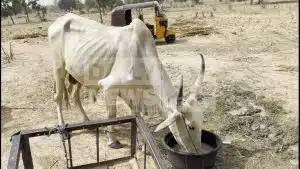
Borehole, yet no water
Irrespective of the borehole project commissioned to the community about four months ago, residents have gone back to their former source of water supply as they revealed to Daily News24 that the borehole no longer serves them.
When our reporter visited the community recently, an 81-year-old Mallam Adamu Adamu sat under a deep-rooted Dogon Yaro tree, gazing at the non-functional borehole. His lanky dark skin shines as he says that the borehole no longer serves them.
He was oblivious as to why the borehole stopped working a few months after it was commissioned.
He recalls the day it was commissioned, saying that members of the Yandachi community now rely on neighbouring communities for water asides from the ditch, which was 1 kilometre away.
“Our people now have to walk to Rimi and other neighbouring communities since the borehole stopped working. Even if the water we get from other communities is fairly good looking, we have no option other but to do anything we get. You have seen for yourself, and the little children have to toil to get water.
“Sometimes, when I observe the setbacks this insufficiency of water has caused to the children and other members of the community, it makes me weep. Yesterday I was asking Mallam Yusuf (a community member) the reason why the borehole stopped working, but he had no answer to my question.”
Mallam Adamu spoke as he tried not to give in to his emotions.
As observed by our reporter, Yandachi residents do not take any purification processes before drinking the brownish looking water.
Just like residents drink the contaminated water, animals also drink the same. They are exposed to diseases that come with dirty water.
According to the World Health Organization (WHO), contaminated water can transmit diarrhoea, cholera, dysentery, typhoid, and polio. Dirty drinking water is estimated to cause 485 000 diarrhoeal deaths each year.

The United Nations International Children’s Emergency Fund (UNICEF) states that the use of contaminated drinking water and poor sanitary conditions increases vulnerability to water-borne diseases, including diarrhoea which leads to deaths of more than 70,000 children under five annually.
The poor access to potable drinking water in the Yandachi community remains a major contributing factor to non-access to education among children in the community.
Newborns also have their share of contaminated water
Like Yandachi, Gogel, a Ward in Warawa LGA share the pains of drinking contaminated water. Unlike Yandachi residents who once had a feel of how clean water tastes like, they have never had any intervention and all members of this community fetch water from an open water body where Ducks, Goats, Cows and Goats also go to drink.
Newborns are not separately treated when born. The lake is where midwives get water they use to bathe newly born babies.
Born in this community, Rabilu Yahaya grew up to drinking this water right from his childhood. He is now in his late twenties and is already accustomed to it. He revealed to Daily News24 that babies also get to drink from this source.
“Because we have no wells in this community, when babies are born, this same water which is full of dirt and unsafe, is used to bathe the child and the mother.
“When the need arises for the child to drink water, this is the water the child is given. Right from when I was growing up till this moment, nothing has changed and no single person is happy with this.” Yahaya said
“We are begging the relevant authorities to come to our aid, we are fed up but we have no option but to continue with this suffering.
“We are leading with the relevant authorities to come to our aid, we are fed up but we have no option but to continue with this suffering” he added.
With microorganisms and other aquatic plants visibly growing beneath the pond, residents no longer care about the health implications of drinking polluted water as it remains the only source for their household use.
Daily News24 observes that the residents are already accustomed to drinking from the pond as they have no other means.
Junaidu Wada, another resident of Gogel community tells this reporter that people in this community are aware of the health implications of consuming the contaminated water from the lake.
He says the community has no other source of water except the lake and that makes their situation gloomy.
“If we had a borehole or well, which could supply us any better water, we would not even consider this lake. As it is, we are stuck with this water.
“For long, we have been hoping that our problem will receive attention. We have the belief that one day, God will bring someone or an organization that will come to our aid.” He said.
When contacted, Ms Habiba Mohammed the Public Relations Officer of Kano State Water Board said that Yandachi’s Borehole had an issue which has been fixed, and that individuals living in Gogel community should send their complains to their local government authorities.


